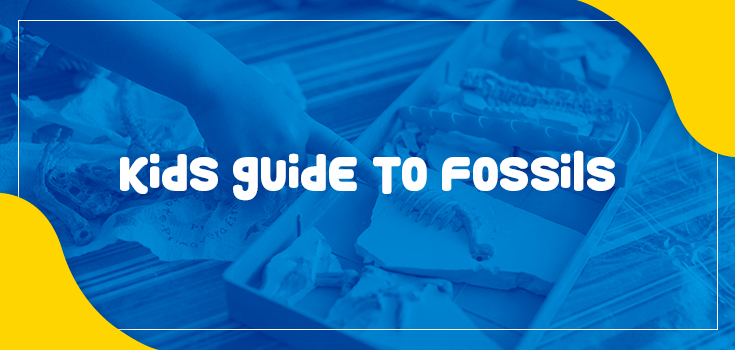Fossils open a window into a world filled with dinosaurs, ancient sea creatures and plants that existed millions of years before humans. Learning about fossils is like being a detective. Each discovery tells a story about Earth’s past!
What Is a Fossil?
Have you ever seen a footprint that someone left behind in wet cement on a sidewalk that became hardened and is now permanent? Fossils are a little like that, but much older. Fossils are parts of animals or plants (or sometimes the whole animal and plant, and yes, even footprints) that were buried in mud, lava or other material a long time ago.
Body vs. Trace Fossils
There are two main types of fossils: body and trace fossils.
Body fossils are the actual remains of an organism, like bones, teeth or shells. When you see a giant dinosaur skeleton in a museum, you’re looking at body fossils. You can even find small body fossils like crinoid fossils, which are ancient marine animals that looked like plants but were related to sea stars.
Trace fossils are signs that an animal or plant was once there, without containing the actual body. These include footprints, nests, burrows and even fossilized poop. A fun fact is that some trace fossils capture a moment in time — like the tracks of a dinosaur running across mud millions of years ago.
How Do Fossils Form?
The process takes a long time and usually happens in a few steps:
- An animal or plant dies and is quickly buried by sediment like sand or mud.
- Over time, more sediment piles on top, protecting the remains.
- Minerals slowly replace the organic material, turning it into rock.
- Millions of years later, erosion or excavation reveals the fossil.
Fun Fossil Facts for Kids
Here are a few fun facts about fossils:
- Most fossils are from sea creatures, even those found far from the ocean today.
- Dinosaur fossils have been discovered on every continent, including Antarctica.
- Each U.S. state has an official state fossil.
- Paleontologists often use tools similar to dentists, such as tiny picks, brushes and even mirrors to examine fossils closely.
Become a Fossil Explorer!
You don’t have to be a scientist to enjoy fossils. Here are some ways kids can start exploring:
- Make your own “fossils” at home by pressing leaves, shells or small toys into clay, then letting them dry.
- Visit local museums or nature centers to see real fossils up close.
- Sign your kid up for a science club where they can learn how fossils connect to Earth’s history.
Science Explorers Helps You Explore Fossils — Sign Up Today!
Fossils show us how amazing and diverse life on Earth has been over millions of years. They help us imagine the dinosaurs that once roamed the land and the footprints left in prehistoric mud.
Science Explorers has been teaching kids about fossils and more since 1999. We offer after-school clubs, summer camps and school programs throughout Pennsylvania, New Jersey, Delaware and Maryland to get children ages 4–11 excited about discovery. Register today for after-school STEM clubs to start the adventure into the world of science. Have a few questions about our programs? Feel free to contact us!

